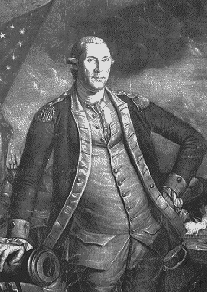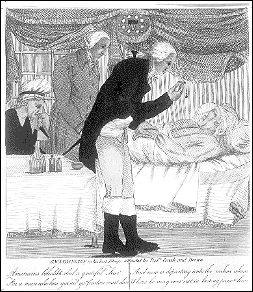Spring 1994, Vol. 26, No. 1
The Surprising George Washington
By Richard Norton Smith
© 1994 by Richard Norton Smith

|
George Washington, engraving by Charles Willson Peale. (Courtesy of the National Portrait Gallery, Smithsonian Institution, Gift of the Barra Foundation.) |
In the autumn of 1787, newly returned from Constitution-making in Philadelphia, the proprietor of Mount Vernon turned his attention to more prosaic matters. George Washington needed a gardener, and he approached the job search with the same psychological insight that had so impressed his fellow delegates. At length he drew up a contract with a hard-drinking candidate, after solemnly binding him to perform his duties sober for one year "if allowed four dollars at Christmas, with which to be drunk four days and four nights; two dollars at Easter, to effect the same purpose; two dollars at Whitsuntide, to be drunk for two days, a dram in the morning, and a drink of grog at dinner and at noon."
It was vintage Washington: a fine medley of bemused tolerance for human frailty and the rigidly methodical demands made upon himself across a lifetime of self-improvement. Nearly two hundred years after his death, no American is more instantly recognizable to--or more remote from--his descendants. Standing in a thousand city parks, frozen in marbled veneration, the Father of His Country inspires more awe than affection. According to Newsweek, 14 percent of all American preschoolers think that George Washington is still sitting in the Oval Office. To the rest of us, Washington appears every February to sell cars and appliances before vanishing into the historical mists, the Ultimate Dead White Male.
His contemporaries were less willing to let him go. On the last night of his life, having defied the might of the British empire and planted the seeds of republican government, the old hero was invited to challenge the very laws of nature. Among those who learned of Washington's lethally sore throat was his friend William Thornton, a practicing doctor and amateur architect who had secretly designed the new Capitol building in Washington city as a final resting place for his friend. In hopes of forestalling that event, Dr. Thornton hurried to Mount Vernon to perform an emergency tracheotomy.
He arrived too late, or so it seemed to everyone but the good doctor. Refusing to accept the verdict of death, this quintessential child of the Enlightenment proposed to resurrect Washington "in the following manner. First to thaw him in cold water, then to lay him in blankets, and by degrees and by friction to give him warmth, and to put into activity the minute blood vessels, at the same time to open a passage to the lungs by the trachea, and to inflate them with air, to produce an artificial respiration, and to transfuse blood into him from a lamb."
Washington's friends intervened to permit him a peaceful departure. Yet just four years later, John Marshall would attempt in five ponderous volumes what Dr. Thornton had only theorized with his blankets and his lamb's blood--to restore George Washington to life. By most accounts he failed. According to the waspish John Adams, Marshall's work was not a biography at all but "a Mausoleum, one hundred feet square at the base and two hundred feet high."

|
|
The death of Washington became a subject of popular prints that idealized the passing of a venerated hero (NARA 148-GW-590). Here an adulatory verse completes the picture:
Americans behold & shed a grateful Tear |
Artists fared no better than writers. Even during Washington's lifetime, family members complained that his portraits barely did him justice. Gilbert Stuart insisted that conveying Washington's personality on canvas was the most difficult thing in the world. In truth, Stuart and Washington did not exactly hit it off during their numerous sessions together, and the painter's revenge--the so-called postage slot mouth caused by stuffing cotton in place of the President's badly made dentures--has shaped, or warped, our image of Washington ever since.
Sooner or later everyone who writes about Washington must come to terms with the bloodless image stamped upon our currency and our car sales. In an age suspicious of heroics and squeamish about duty, it is no exaggeration to say that our first President falls victim to his own well-publicized virtues. Blame it on Parson Weems and his adulatory imitators, who robbed Washington's life of conflict, tension, and the slowly gathering forces of character. Since few of us can identify with human perfection, it is hardly surprising that Weems's Saint George should have inspired the shallow debunkers of the 1920s or the well-meaning yet distorting "humanizers" of more recent years. All too often the humanizers wound up merely trivializing Washington, telling us more than we need to know about his false teeth and expense accounts, his shadowy passion for Sally Fairfax, or his amply documented lust for land and social status.
The Surprising George Washington, Part 2
The Surprising George Washington, Part 3
The Surprising George Washington, Part 4
| Articles published in Prologue do not necessarily represent the views of NARA or of any other agency of the United States Government. |